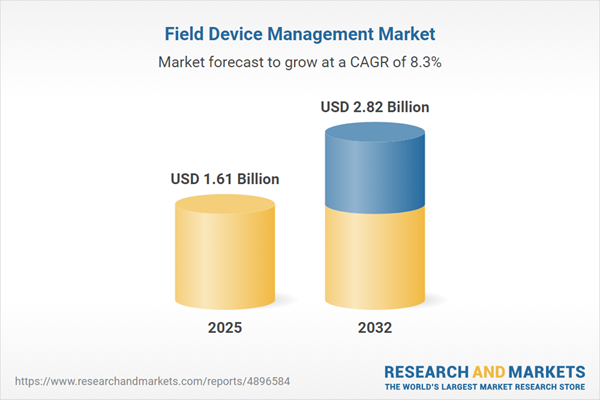Speak directly to the analyst to clarify any post sales queries you may have.
Field device management is reshaping the way industrial operations achieve reliability, compliance, and operational agility. With rapid digitalization transforming sector expectations, managing field assets efficiently is now central to sustaining performance and responding proactively to regulatory and market shifts.
Market Snapshot: Field Device Management Market Size and Growth
The field device management market is undergoing significant growth, with its value reaching USD 1.49 billion in 2024 and forecasted to expand to USD 1.61 billion by 2025. This market demonstrates a compound annual growth rate (CAGR) of 8.29% and is projected to attain USD 2.82 billion by 2032. This momentum is a direct result of widespread adoption of automation in industrial sectors, modernization of aging infrastructure, and deeper integration of digital solutions throughout operational processes. Strategic investments are now prioritized to advance asset transparency, facilitate compliance, and introduce adaptive approaches that align with evolving performance requirements.
Scope & Segmentation of the Field Device Management Market
- Offering: Hardware, software, integration, consulting, training, and support collectively form a comprehensive ecosystem, enabling real-time analytics, easy device setup, proactive diagnostics, and ongoing condition monitoring to boost asset reliability.
- Component: Lifecycle management, device calibration, parameter setting, and analytical tools are foundational, optimizing uptime and workflow efficiency for critical infrastructure sectors.
- Deployment Mode: Cloud-based and on-premises deployment options provide tailored flexibility to meet varied regulatory mandates and data governance standards across organizations and geographic regions.
- End User: Sectors such as chemicals, pharmaceuticals, petrochemicals, food and beverage, metals and mining, oil and gas, water management, and utilities leverage these solutions to meet regulatory needs, improve safety, and drive operational gains.
- Geography: North America, Europe, Middle East, Africa, and Asia-Pacific regions exhibit different adoption rates and regulatory demands, shaping deployment strategies and investment levels suited to their maturity and requirements.
- Technology Drivers: Key enablers include industrial networking, cloud and edge computing, and predictive diagnostics. Standards like IEC 62443 and OPC Unified Architecture reinforce interoperability and regulatory readiness.
- Key Companies: Leading innovation and product development are Emerson Electric Co., ABB Ltd., Siemens AG, Schneider Electric SE, Honeywell International Inc., Rockwell Automation Inc., Yokogawa Electric Corporation, Endress+Hauser AG, VEGA Grieshaber KG, and KROHNE Messtechnik GmbH.
Key Takeaways for Senior Decision-Makers
- Automating field device oversight streamlines maintenance, enhances asset reliability, and supports rapid problem detection across industrial sites.
- Advanced diagnostics and analytics facilitate early identification of operational risks, easing the transition to next-generation asset control.
- Standardized communication protocols enhance deployment efficiency across different facilities, supporting simpler compliance management and scalable rollouts.
- Flexible deployment models ensure that strategies can be adapted for changing business needs, safeguarding technology investments amid evolving regulations and industry trends.
- Access to specialized consulting and training fosters in-house expertise, accelerating technology adoption and measurable outcome improvements.
- Centralized data oversight supports executive-level resource allocation and reinforces long-term value realization across asset portfolios.
Tariff Impact: Navigating Shifting Supply Chains
- Organizations are refining supply chain strategies and inventory controls in response to new global tariff structures, strengthening business resilience and agility.
- By increasing regional sourcing and leveraging digital customization, businesses offset disruptions, ensure greater operational stability, and adapt to changing market needs.
Research Methodology & Data Sources
Findings are grounded in comprehensive secondary research, expert interviews, peer-reviewed literature, and direct input from industry leaders. Field surveys and benchmarking further refine the analysis, providing actionable support for executive planning and decisions.
Field Device Management Market: Why This Report Matters
- Senior leaders can align technology initiatives with compliance and automation strategies to improve efficiency and streamline processes across asset networks.
- The analysis clarifies how to strengthen competitive positioning, implement risk mitigation, and prioritize actions for broad compliance and transformation.
- Executives gain clear direction to optimize processes, lead digital transformation, and drive accountability in complex and rapidly changing environments.
Conclusion
Effective field device management delivers secure, adaptable, and resilient industrial operations. Executives using these insights are positioned to lead transformation, ensure compliance, and respond with certainty to shifting industrial demands.
Additional Product Information:
- Purchase of this report includes 1 year online access with quarterly updates.
- This report can be updated on request. Please contact our Customer Experience team using the Ask a Question widget on our website.
Table of Contents
3. Executive Summary
4. Market Overview
7. Cumulative Impact of Artificial Intelligence 2025
Companies Mentioned
The companies profiled in this Field Device Management market report include:- Emerson Electric Co.
- ABB Ltd.
- Siemens AG
- Schneider Electric SE
- Honeywell International Inc.
- Rockwell Automation Inc.
- Yokogawa Electric Corporation
- Endress+Hauser AG
- VEGA Grieshaber KG
- KROHNE Messtechnik GmbH
Table Information
| Report Attribute | Details |
|---|---|
| No. of Pages | 188 |
| Published | November 2025 |
| Forecast Period | 2025 - 2032 |
| Estimated Market Value ( USD | $ 1.61 Billion |
| Forecasted Market Value ( USD | $ 2.82 Billion |
| Compound Annual Growth Rate | 8.2% |
| Regions Covered | Global |
| No. of Companies Mentioned | 11 |









